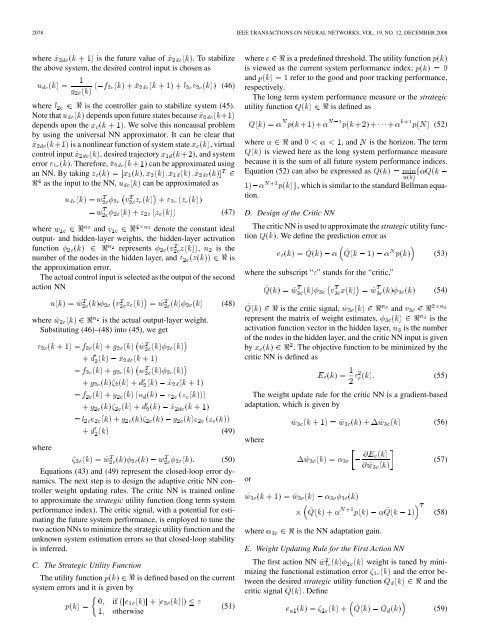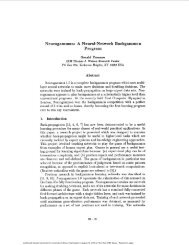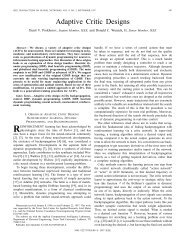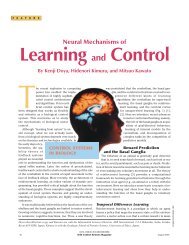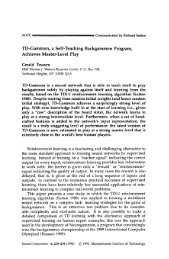Neural-Network-Based State Feedback Control of a ... - IEEE Xplore
Neural-Network-Based State Feedback Control of a ... - IEEE Xplore
Neural-Network-Based State Feedback Control of a ... - IEEE Xplore
Create successful ePaper yourself
Turn your PDF publications into a flip-book with our unique Google optimized e-Paper software.
2078 <strong>IEEE</strong> TRANSACTIONS ON NEURAL NETWORKS, VOL. 19, NO. 12, DECEMBER 2008<br />
where is the future value <strong>of</strong> . To stabilize<br />
the above system, the desired control input is chosen as<br />
(46)<br />
where is the controller gain to stabilize system (45).<br />
Note that depends upon future states because<br />
depends upon the . We solve this noncausal problem<br />
by using the universal NN approximator. It can be clear that<br />
is a nonlinear function <strong>of</strong> system state , virtual<br />
control input , desired trajectory , and system<br />
error . Therefore, can be approximated using<br />
an NN. By taking<br />
as the input to the NN, can be approximated as<br />
(47)<br />
where and denote the constant ideal<br />
output- and hidden-layer weights, the hidden-layer activation<br />
function represents , is the<br />
number <strong>of</strong> the nodes in the hidden layer, and<br />
is<br />
the approximation error.<br />
The actual control input is selected as the output <strong>of</strong> the second<br />
action NN<br />
where<br />
is the actual output-layer weight.<br />
Substituting (46)–(48) into (45), we get<br />
(48)<br />
where is a predefined threshold. The utility function<br />
is viewed as the current system performance index;<br />
and refer to the good and poor tracking performance,<br />
respectively.<br />
The long term system performance measure or the strategic<br />
utility function is defined as<br />
(52)<br />
where and , and is the horizon. The term<br />
is viewed here as the long system performance measure<br />
because it is the sum <strong>of</strong> all future system performance indices.<br />
Equation (52) can also be expressed as<br />
, which is similar to the standard Bellman equation.<br />
D. Design <strong>of</strong> the Critic NN<br />
The critic NN is used to approximate the strategic utility function<br />
. We define the prediction error as<br />
where the subscript “ ” stands for the “critic,”<br />
(53)<br />
(54)<br />
is the critic signal,<br />
and<br />
represent the matrix <strong>of</strong> weight estimates,<br />
is the<br />
activation function vector in the hidden layer, is the number<br />
<strong>of</strong> the nodes in the hidden layer, and the critic NN input is given<br />
by<br />
. The objective function to be minimized by the<br />
critic NN is defined as<br />
(55)<br />
The weight update rule for the critic NN is a gradient-based<br />
adaptation, which is given by<br />
(49)<br />
where<br />
(50)<br />
Equations (43) and (49) represent the closed-loop error dynamics.<br />
The next step is to design the adaptive critic NN controller<br />
weight updating rules. The critic NN is trained online<br />
to approximate the strategic utility function (long term system<br />
performance index). The critic signal, with a potential for estimating<br />
the future system performance, is employed to tune the<br />
two action NNs to minimize the strategic utility function and the<br />
unknown system estimation errors so that closed-loop stability<br />
is inferred.<br />
C. The Strategic Utility Function<br />
The utility function is defined based on the current<br />
system errors and it is given by<br />
if<br />
otherwise<br />
(51)<br />
(56)<br />
where<br />
(57)<br />
or<br />
(58)<br />
where is the NN adaptation gain.<br />
E. Weight Updating Rule for the First Action NN<br />
The first action NN<br />
weight is tuned by minimizing<br />
the functional estimation error and the error between<br />
the desired strategic utility function<br />
and the<br />
critic signal . Define<br />
(59)


